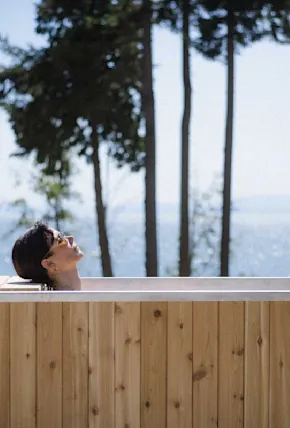A Quick Glance at Infrared Saunas
Infrared saunas use infrared light technology to directly heat your body rather than heating the air in the room. The temperature is typically much lower and it doesn't use an electric sauna heater with hot rocks, but instead creates heat with high-tech panels.
The gentler heat and lower temperatures of an infrared sauna are great for those who might have an increased risk and experience adverse side effects in high heat. An infrared sauna has also been shown to have health benefits that go beyond skin deep—rejuvenating the body on a cellular level. Depending on your available space and preference for indoor saunas or outdoor sauna, the infrared sauna can be both.
Dry Sauna Benefits & How to Get the Most Out Of Sauna Sessions
There is more and more research backing up the centuries old claims that a dry sauna is good for you. A recent study showed that regular dry sauna bathing has several health benefits that does more than improve overall well being, but even target specific conditions.
In every sauna session, the focus is on embracing relaxation while bathing high temperatures—this leads to improved circulation, relieving stress from stiff muscles (which is beneficial for muscle recovery post-workout), and a cleansing sweat that's great for opening pores, possibly even improving mild skin conditions.
On a therapeutic level, the study, Clinical Effects of Regular Dry Sauna Bathing: A Systematic Review studied repeat sauna use to gather medical evidence that showed users with certain medical conditions can successfully use sauna therapy as a way to alleviate the symptoms or even improve chronic obstructive pulmonary disease, rheumatoid arthritis cardiovascular disease, allergic rhinitis, heart disease, and weight loss.
When pairing a sauna session with a cold plunge, you're able to rid the body of excess heat; anecdotally, many sauna users experience a feeling of deep relaxation followed by a jolt of energy and endorphins from exposure to the cold. Some even claim this thermoregulatory practice leads to an increased metabolism, but the jury is still out!
That said, the hot-cold cycle does have some evidence to support the belief that sauna sessions and cold plunges have several health benefits. What's for sure is that incorporating dry sauna sessions into your wellness routine is a great way to take care of your body, relax your mind, and after all that sweating, enjoy an even better sleep.

Photo by author Katherine Englishman of her own Dry Sauna
Optimal Dry Sauna Temperature, Duration, and Maximizing Health Benefits
Getting the most out of using a traditional sauna is always about listening to what's best for your body and not exceeding your limits. That said, a good temperature range for most sauna users is 140-160 F, for a slightly lower temperature and heat that isn't super intense, but will still provide all the health benefits. Crank it up to 160-195 F for a deeper heat and more invigorating sweat session, but do not exceed 210 F, because this super high temperature will have adverse side effects on the body.
Like with all types of saunas, it's important to drink plenty of water before, after, and even during the sauna session (do not bring stainless steel or metal water bottles into the sauna!) to prevent dehydration, and always avoid alcohol prior to using the sauna. Sauna is not recommended for those with acute cardiovascular disease, heart disease, pregnant women, and other high-risk medical conditions. If you have questions or concerns, talk to your doctor before the sauna.
The length of time for your sauna session is up to you, but a good rule of thumb is to sauna for 10-15 minutes, step out for five minutes to let the body cool down, and start the cycle again for as long as you feel comfortable. During repeat sauna sessions, always remember to adjust the heat when needed and listen to how your body feels. Exit if you feel lightheaded, experience extreme discomfort, or any other symptoms.











